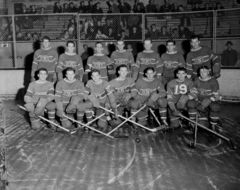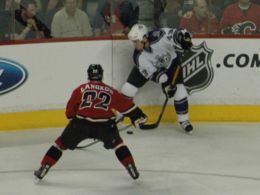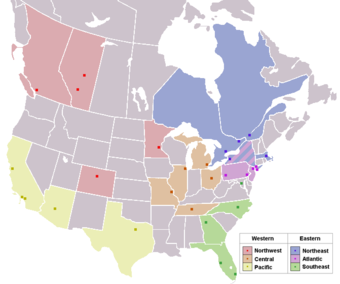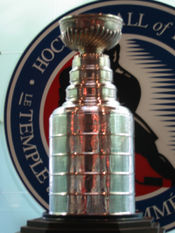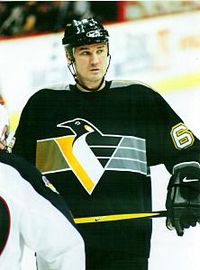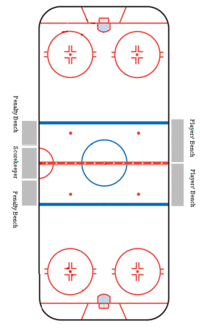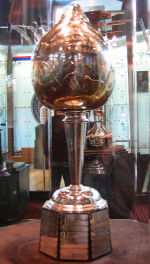National Hockey League
2007 Schools Wikipedia Selection. Related subjects: Sports events
| National Hockey League | |
|---|---|
 |
|
| Sport | Ice hockey |
| Founded | 1917 |
| No. of teams | 30 |
| Country | |
| Current champions | Carolina Hurricanes |
| Official website | NHL.com |
The National Hockey League (NHL) is a professional sports organization composed of ice hockey teams in North America. Its French name is Ligue Nationale de Hockey (LNH). It is the premier professional ice hockey league in the world, and one of the North American major professional sports leagues. The league's teams are divided into two conferences, each comprising three divisions.
The league was founded in 1917 in Montreal, Quebec with five teams, and through a series of expansions, reductions and relocations is now composed of 30 teams, 24 of which are based in the United States and six in Canada. After a labour dispute that led to the cancellation of the complete 2004–05 season, the league has staged a successful 2005–06 regular season and 2006 Stanley Cup Playoffs.
Historically, due to its origins in Canada, a large majority of players in the National Hockey League are Canadians. Over the past 25 years, due to the NHL's continued expansion into the United States, its high standard of play compared to other leagues, and the availability of highly skilled European players from Eastern Europe after the fall of communism, there has been an increasing presence of American and European players. Nevertheless, more than half of the league's players on the 2005–06 roster were born in Canada.
History
After a series of disputes in the Canadian National Hockey Association (NHA) between the owner of the Toronto Blueshirts and the owners of other teams, all the owners met at the Windsor Hotel in Montreal to talk about the NHA's future. Their discussions eventually led to the creation of the National Hockey League in 1917; the founding teams were the Montreal Canadiens, Montreal Wanderers, Ottawa Senators, Quebec Bulldogs and the newly-renamed Toronto Arenas.
Even though the league struggled to stay in business during its first decade, the NHL's teams were very successful on the ice; during the NHL's first nine years, NHL teams won the Stanley Cup seven times. By 1926 the NHL was the only league competing for the Stanley Cup. The NHL then started a process of expansion; the Hamilton Tigers were added in the 1920–21 season; the Boston Bruins (the first United States based NHL franchise in 1924) and Montreal Maroons entered the league in 1924–25; the New York Americans and the Pittsburgh Pirates entered in the 1925–26 season; and the New York Rangers, Chicago Blackhawks, and the Detroit Cougars (now known as the Red Wings) entered in the 1926–27 season. By the end of the 1930–31 season, the NHL had a total of 10 teams. Among other reasons, the Great Depression and the onset of World War II, however, took a toll on the league, and the NHL was reduced to six teams in 1942. These six teams (Montreal Canadiens, Toronto Maple Leafs, Detroit Red Wings, Chicago Blackhawks, Boston Bruins, and New York Rangers) are collectively known as the Original Six, and for the next quarter-century were the only teams in the National Hockey League.
The rise of the Western Hockey League, which many pundits thought would transform into a major league and challenge for the Stanley Cup, spurred the NHL in 1967 to undertake its first expansion since the 1920s. Six new teams were added to the NHL roster, and placed in their own newly-created division. These six teams included the Philadelphia Flyers, St. Louis Blues, Minnesota North Stars, Los Angeles Kings, Oakland Seals, and Pittsburgh Penguins. Three years later, the NHL added the Vancouver Canucks and Buffalo Sabres as franchises.
In 1972, the World Hockey Association (WHA) was formed and though it never challenged for the Stanley Cup, its status as a potential rival to the NHL did not go unnoticed. In response, the NHL decided to rush its own expansion plans by adding the New York Islanders and Atlanta Flames in the same year, which was followed by the addition of the Kansas City Scouts and Washington Capitals two years later. The two leagues fought for hockey players and fans until the WHA folded in 1979. Four of the remaining six WHA teams merged into the NHL: the Hartford Whalers, Québec Nordiques, Edmonton Oilers, and Winnipeg Jets.
In the early 1990s, the NHL further expanded with five new franchises. The San Jose Sharks entered in 1991; a season later the Ottawa Senators would join the NHL along with the Tampa Bay Lightning. In 1993, the league added two additional teams, the Mighty Ducks of Anaheim and the Florida Panthers. Approaching the new millennium, the NHL added another four teams: the Nashville Predators (1998), the Atlanta Thrashers (1999), the Minnesota Wild and the Columbus Blue Jackets (both added in 2000), bringing the total to 30 teams.
Game
Each National Hockey League regulation game is an ice hockey game played between two teams and is 60 minutes long. The game is composed of three 20-minute periods with an intermission of 15.5 minutes (17-minutes for nationally televised games) between periods. At the end of the 60 minute regulation time, the team with the most goals wins the game. If a game is tied after regulation time, overtime ensues. During the regular season, overtime is a five-minute, four-player on four-player sudden-death period, in which the first team to score a goal wins the game. Beginning in 2005–06, if the game is still tied at the end of overtime, the game enters a shootout. Three players for each team in turn take a penalty shot. The team with the most goals during the three round shootout wins the game. If the game is still tied after the three shootout rounds, the shootout continues, but becomes sudden death. Whichever team ultimately wins the shootout is awarded the goal. Shootout goals and saves are not tracked in hockey statistics; Shootout statistics are tracked separately.
Shootouts do not occur during the playoffs. In the playoffs, an unlimited number of sudden-death 20 minute five-on-five periods occur until one team scores. While a game can theoretically continue forever, only a handful of games have ever surpassed four overtime periods, and none have gone beyond six.
Teams
The National Hockey League originated in 1917 with 5 teams, and through a sequence of team expansions, reductions and relocations currently consists of 30 teams, 24 of which are based in the United States and 6 in Canada. The Montreal Canadiens are the most successful franchise with twenty-four Stanley Cup championships; in the four major North American professional sports leagues the Montreal Canadiens are only surpassed in the number of championships by the New York Yankees of Major League Baseball. The next most successful franchise is the Toronto Maple Leafs with thirteen Stanley Cups, but they have not won a championship since 1967. The Detroit Red Wings, with 10 Stanley Cups, are the most successful American franchise. The longest streak of winning the Stanley Cup in consecutive years is five held by the Montreal Canadiens from 1955-56 to 1959-60; the New York Islanders (from 1980-1983) and the Montreal Canadiens (from 1976-1979) have four-year championship streaks. The 1977 edition of the Montreal Canadiens, the second of four straight Stanley Cup champions, was named by ESPN as the second greatest sports team of all-time. More recently, the Carolina Hurricanes and the Tampa Bay Lightning have won the Stanley Cup in the past two seasons.
Of the four major leagues in the United States, the NHL is the only league to field teams that play in the capital cities of two countries (Ottawa and Washington, D.c.. The league also boasts more Canadian teams than the three other major leagues (the NBA and MLB both have one each, both based in Toronto. The NHL currently has six.
The current league organization divides the teams into two conferences. Each conference has three divisions, and each division has 5 teams. The current organization has roots in the 1998–99 season where a league realignment added two divisions to bring the total number of divisions to six; the current team alignment began with the 2000–2001 season when the Minnesota Wild and the Columbus Blue Jackets joined the league as expansion teams.
Eastern Conference
| Division | Team | City | Arena | Capacity |
|---|---|---|---|---|
| Atlantic | New Jersey Devils | East Rutherford, New Jersey | Continental Airlines Arena | 19,040 |
| New York Islanders | Uniondale, New York | Nassau Veterans Memorial Coliseum | 16,297 | |
| New York Rangers | New York, New York | Madison Square Garden | 18,200 | |
| Philadelphia Flyers | Philadelphia, Pennsylvania | Wachovia Centre | 19,500 | |
| Pittsburgh Penguins | Pittsburgh, Pennsylvania | Mellon Arena | 17,181 | |
| Northeast | Boston Bruins | Boston, Massachusetts | TD Banknorth Garden | 17,565 |
| Buffalo Sabres | Buffalo, New York | HSBC Arena | 18,690 | |
| Montreal Canadiens | Montreal, Quebec | Bell Centre | 21,273 | |
| Ottawa Senators | Ottawa, Ontario | Scotiabank Place | 20,004 | |
| Toronto Maple Leafs | Toronto, Ontario | Air Canada Centre | 18,800 | |
| Southeast | Atlanta Thrashers | Atlanta, Georgia | Philips Arena | 18,750 |
| Carolina Hurricanes | Raleigh, North Carolina | RBC Centre | 18,730 | |
| Florida Panthers | Sunrise, Florida | BankAtlantic Centre | 19,452 | |
| Tampa Bay Lightning | Tampa, Florida | St. Pete Times Forum | 19,500 | |
| Washington Capitals | Washington, D.C. | Verizon Centre | 19,700 |
Western Conference
| Division | Team | City | Arena | Capacity |
|---|---|---|---|---|
| Central | Chicago Blackhawks | Chicago, Illinois | United Centre | 20,500 |
| Columbus Blue Jackets | Columbus, Ohio | Nationwide Arena | 18,500 | |
| Detroit Red Wings | Detroit, Michigan | Joe Louis Arena | 19,383 | |
| Nashville Predators | Nashville, Tennessee | Gaylord Entertainment Centre | 17,113 | |
| St. Louis Blues | St. Louis, Missouri | Scottrade Centre | 19,260 | |
| Northwest | Calgary Flames | Calgary, Alberta | Pengrowth Saddledome | 20,140 |
| Colorado Avalanche | Denver, Colorado | Pepsi Centre | 18,007 | |
| Edmonton Oilers | Edmonton, Alberta | Rexall Place | 16,839 | |
| Minnesota Wild | St. Paul, Minnesota | Xcel Energy Centre | 18,600 | |
| Vancouver Canucks | Vancouver, British Columbia | General Motors Place | 18,630 | |
| Pacific | Anaheim Ducks | Anaheim, California | Honda Centre | 17,147 |
| Dallas Stars | Dallas, Texas | American Airlines Centre | 18,500 | |
| Los Angeles Kings | Los Angeles, California | Staples Centre | 18,500 | |
| Phoenix Coyotes | Glendale, Arizona | Jobing.com Arena | 18,000 | |
| San Jose Sharks | San Jose, California | HP Pavilion | 17,483 |
Season structure
The National Hockey League season is divided into a regular season, where teams play each other in a predefined schedule, and a playoffs, which is an elimination tournament where two teams play against each other to win a best-of-seven series in order to advance to the next round. The final remaining team is crowned the Stanley Cup champions. The past season is the 2005–06 regular season, which culminated with the 2006 Stanley Cup Playoffs.
In the regular season, each team plays 82 games; 41 games at home and 41 on the road. Beginning in 2005-06 regular season, of the 82 games, teams play 32 games within their division, 40 games against non-divisional intra-conference opponents and 10 inter-conference games (1 game against each team in two of the three divisions in the opposite conference). The two divisions from the opposite conference which each team plays against are rotated every year, much like interleague play in baseball. Points are awarded for each game, where two points are awarded for a win, one point for losing in overtime or a shootout, and zero points for a loss in regulation. Among major professional sports leagues, the NHL is the only one to award a team points for losing in overtime.
At the end of the regular season, the team that finishes with the most points in each division is crowned the division champion with the league overall leader awarded the Presidents' Trophy. The three division champions along with the five other teams in each conference with the next highest number of points, for a total of 8 teams in each conference, qualify for the playoffs. The division winners are seeded one through three (even if a non-division winner has a higher point total), and the next five teams with the best records in the conference are seeded four through eight. The Stanley Cup Playoffs is an elimination tournament, where two teams battle to win a best-of-seven series in order to advance to the next round. The first round of the playoffs, or conference quarterfinals, consists of the first seed playing the eighth seed, the second playing the seventh, third playing the sixth, and the fourth playing the fifth. In the second round, or conference semifinals, the NHL re-seeds the teams, with the top remaining conference seed playing against the lowest remaining seed, and the other two remaining conference teams pairing off. In the third round, the conference finals, the two remaining teams in each conference play each other, with the conference champions proceeding to the Stanley Cup Finals.
In each round the higher-ranked team is said to be the team with the home-ice advantage. Four of the seven games are played at this team's home venue — the first and second, and, when necessary, the fifth and seventh games — with the other games played at the lower-ranked team's home venue.
Notable players
The best known NHL players have historically included Gordie Howe, Bobby Orr, Maurice Richard, Howie Morenz, Newsy Lalonde, Jacques Plante, Eddie Shore and Bobby Hull. In recent years, Wayne Gretzky, Mario Lemieux, Steve Yzerman, Ray Bourque, Mark Messier, Pavel Bure and Patrick Roy were among the most celebrated and honoured players.
The top five scoring forwards in the 2005–06 season were Joe Thornton, Jaromir Jagr, Alexander Ovechkin, Daniel Alfredsson, and Dany Heatley. The top three scoring defencemen were Nicklas Lidstrom, Sergei Zubov, and Bryan McCabe, and the top three goaltenders (by wins) were Martin Brodeur, Miikka Kiprusoff, and Marty Turco. The rookie race between Alexander Ovechkin and Sidney Crosby also garnered much attention during the 2005-06 season.
In addition to Canadian and American players, which have historically composed a large majority of NHL players, the NHL draws players from all over the world. Since the 1990s when communism collapsed in Eastern Europe and the newly formed nations did not restrict the movements of players there has been a large increase in amount of European players in the NHL. European players were drafted and signed by NHL teams in an effort to bring in more skilled offensive players. The addition of European players has changed the style of play in the NHL considerably; European style hockey has been accepted, if not embraced, in the NHL. The league also voluntarily stops its season so that its players can play in the Winter Olympics to have the players represent their own country. Currently the NHL has players from 18 different countries, with the majority still coming from Canada.
For more information about the origins of NHL players, see the List of NHL statistical leaders by country.
Hockey rink
National Hockey League games are played on a hockey rink which is rectangular ice rink with rounded corners and surrounded by a wall. It measures 25.91 by 60.92 metres (85 by 200 ft) in the NHL, while international standards call for a rink measuring 60–61 metres long by 29–30 metres wide (196.85–200.13 ft by 95.14–98.43 ft). The centre line divides the ice in half, and is used to judge icing violations. There are two blue lines that divide the rink roughly into thirds, which divide the ice into two attacking and one neutral zone. Near the end of both ends of the rink, there is a thin red goal line spanning the width of the ice, which is used to judge goals and icing calls.
Starting in the 2005–2006 season, after testing in the American Hockey League, a trapezoid area behind each goal net has been introduced. The goaltender can only play the puck within that area or in front of the goal line; if the goaltender plays the puck behind the goal line and not in the trapezoid area, a 2 minute minor penalty for delay of game is assessed by the referees.
Rules
While the National Hockey League follows the general rules of ice hockey, it differs slightly from those used in international games organized by the International Ice Hockey Federation (IIHF) such as the Olympics. Infractions of the rules can lead to either the stoppage of play in the case of offside and icing calls, or a penalty call for more serious infractions.
During the 2004–05 lockout, the league changed some of the rules regarding being offside; first the league removed the offside pass or two-line pass rule, which required a stoppage in play if a pass originating from inside a team's defending zone was completed on the offensive side of the centre line, unless the puck crossed the line before the player; and second the league reinstated the tag-up offside which allows an attacking player a chance to get back onside by to returning to the neutral zone. The changes to the offside rule were one of several rule changes intended to increase overall scoring, which had been in decline since the expansion years of the mid-nineties.
Another rule difference between the NHL and the IIHF rules concerns how icings are called. In the NHL, a linesman stops play due to icing if a defending player (other than the goaltender) touches the puck before an attacking player is able to, in contrast to the IIHF rules where play is stopped the moment the puck crosses the goal line. As a result of the rule changes following the 2004–05 lockout, when a team is guilty of icing the puck they are not allowed to make a line change before the following faceoff.
In regards to penalties, the NHL, in addition to the minor and double minor penalties called in IIHF games, calls major penalties which are more dangerous infractions of the rules, such as fighting, and have a duration of five minutes; this is in contrast to the IIHF rule, where players who fight are ejected from the game. Usually a penalized team cannot replace a player that is penalized on the ice and is thus shorthanded for the duration of the penalty, but if the penalties are coincidental, such as with fighting, both teams remain at full strength. Also, unlike minor penalties, major penalties must be served to their full completion, regardless of number of goals scored during the power play.
Trophies and awards
The National Hockey League presents numerous trophies per year. The most prestigious team award is the Stanley Cup, which is awarded to the league champion at the end of the Stanley Cup playoffs. The team that has the most points in the regular season is awarded the Presidents' Trophy. There are also numerous trophies that are awarded to players based on their statistics during the regular season; they include, among others, the Art Ross Trophy for the league scoring champion (goals and assists), the Maurice 'Rocket' Richard Trophy for the goal-scoring leader, and the William M. Jennings Trophy for the goalkeeper(s) for the team with the fewest goals against them. For the 2005–06 season these statistics-based trophies were awarded to Joe Thornton, and Jonathan Cheechoo of the San Jose Sharks and Miikka Kiprusoff of the Calgary Flames respectively.
The other player trophies are voted on by the Professional Hockey Writers Association or the team general managers. The most prestigious individual award is the Hart Memorial Trophy which is awarded annually to the Most Valuable Player; the voting is conducted by members of the Professional Hockey Writers Association to judge the player who is the most valuable to his team during the regular season. The Vezina Trophy is awarded annually to the person deemed the best goalkeeper as voted on by the general managers of the teams in the NHL. The James Norris Memorial Trophy is awarded annually to the National Hockey League's top defenceman, the Calder Memorial Trophy is awarded annually to the top rookie, and the Lady Byng Memorial Trophy is awarded to the player deemed to combine the highest degree of skill and sportsmanship; all three of these awards are voted on by members of the Professional Hockey Writers Association.
In addition to the regular season awards, the Conn Smythe Trophy is awarded annually to the most valuable player during the NHL's Stanley Cup playoffs. Furthermore, the top coach in the league wins the Jack Adams Award as selected by a poll of the National Hockey League Broadcasters Association. The National Hockey League releases the top three vote getters for all awards, and then names the award winner during the NHL Awards Ceremony.
Players, coaches, officials, and team builders who have had notable careers are eligible to be voted into the Hockey Hall of Fame. For players there is a waiting time of three years after their last professional game; this time period, the shortest of any major sport, has led in three cases ( Gordie Howe, Guy Lafleur and Mario Lemieux) to Hall of Fame members coming out of retirement to play once more. In the past, however, if a player was deemed significant enough, the pending period would be waived; only 10 individuals have been honoured in this manner. In 1999, Wayne Gretzky became the last player to have the three-year restriction waived, and after Gretzky's induction, the NHL declared that he would be the last one to have the waiting period omitted.
Labour issues
There have been three league-wide work stoppages in NHL history, all happening between 1992 and 2005. The first was a strike by the National Hockey League Players Association in April 1992 which lasted for 10 days, but the strike was settled quickly and all affected games were rescheduled. A lockout at the start of the 1994–95 forced the league to reduce the schedule from 84 games to just 48, with the teams playing only intra-conference games during the reduced season. The resulting collective bargaining agreement was set for renegotiation in 1998 and extended to September 15, 2004.
With no new agreement in hand when the existing contract expired on September 15, 2004, league commissioner Gary Bettman announced a lockout of the players union and cessation of operations by the NHL head office. The lockout shut down the league for 310 days, the longest in sports history; the NHL was the first professional sports league to lose an entire season. The league vowed to install what it dubbed "cost certainty" for its teams, but the National Hockey League Players Association countered that the move was little more than a euphemism for a salary cap, which the union initially said it would not accept. A new collective bargaining agreement was ratified in July 2005 with a term of six years with an option of extending the collective bargaining agreement for an additional year at the end of the term, allowing the NHL to resume as of the 2005–06 season.
On October 5, 2005, the first post-lockout NHL season took to the ice with 15 games. Of those 15 games, 11 were in front of sell out crowds. The NHL received record attendance in the 2005–06 season. 20,854,169 fans, an average of 16,955 per game, was a 1.2% increase over the previous mark held in the 2001–02 season. Also, the Montreal Canadiens, Colorado Avalanche, and the Vancouver Canucks sold out all of their home games; all six Canadian teams played to 98% capacity or better at every home game. Twenty-four of the thirty clubs finished even or ahead of their 2003–04 mark. The Pittsburgh Penguins had the highest increase at 33%, probably because of Canadian phenom Sidney Crosby.
Television and radio
In Canada, National Hockey League games are aired nationally by the Canadian Broadcasting Corporation (CBC) and The Sports Network (TSN). Regional games are broadcast by a number of networks including Rogers Sportsnet (RSN). French language games are broadcast by the Réseau des sports (RDS), but no longer is on Radio-Canada (the French-language counterpart of the CBC), which created a contreversy in French-speaking Canada. The program Hockey Night in Canada, aired on Saturday nights on CBC, is a long-standing Canadian tradition since first airing on television in 1952. During the playoffs, the CBC airs all games that involve Canadian teams and the Stanley Cup finals; TSN airs certain other games during the first three rounds.
In the United States NHL games are aired nationally by Versus (previously the "Outdoor Life Network" and "OLN"), and by NBC. NBC replaced the previous over-the-air network, ABC, and has a revenue-sharing deal with the NHL. Versus replaced ESPN as the cable network; Comcast, which owns Versus, offered a two-year $120 million deal, while ESPN offered a revenue sharing deal.
Versus has about 20 million fewer subscribers than ESPN, but Comcast switched Versus from a digital tier to basic cable to make NHL games available to more cable subscribers. For Versus the NHL coverage was a good addition as Versus' ratings grew by about 275% when it showed an NHL game,, but television ratings in the United States have seen record lows. Versus posted a 0.4 rating for the 2006 playoffs while ESPN posted a 0.7 rating two years ago; NBC posted a rating of 1.1, compared to ABC's 1.5 rating two years ago.
In Canada, for the first four games of the Stanley Cup finals, the CBC averaged 2.63 million viewers, and RDS averaged 346,000 viewers. In the United States ratings fared worse due to the inclusion of two small-market teams, including one Canadian team; the first two games on Versus posted a 0.9 rating (621,000 households), and game 3 and game 4 on NBC had ratings of 1.6 and 2.0 respectively (1.7 million and 2.2 million households). In 1994, when the New York Rangers were involved, game 7 of the Stanley Cup finals posted a rating of 5.2. Game 7 of the Stanley Cup playoffs gained the highest Stanley Cup rating in the series with a rating of 3.5 (3.8 million households), but it was down from the previous season's game 7 final.
Currently, both XM Satellite Radio & Sirius Satellite Radio and their Canadian counterparts broadcast over 1000 games on their respective services. Starting with the 2007-2008 season, XM Satellite Radio will be the exclusive satellite radio partner of the NHL.
